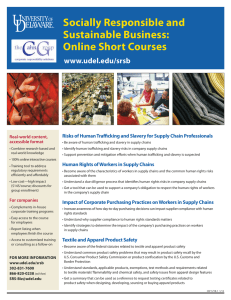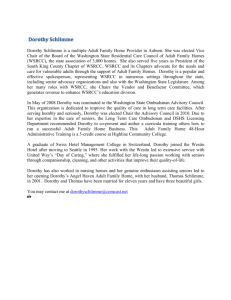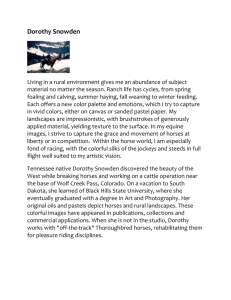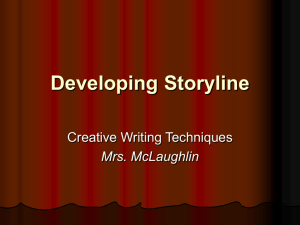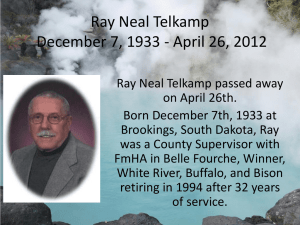Week of January 24, 2014 Spotlight: Dorothy Stang, A Rainforest Martyr
advertisement
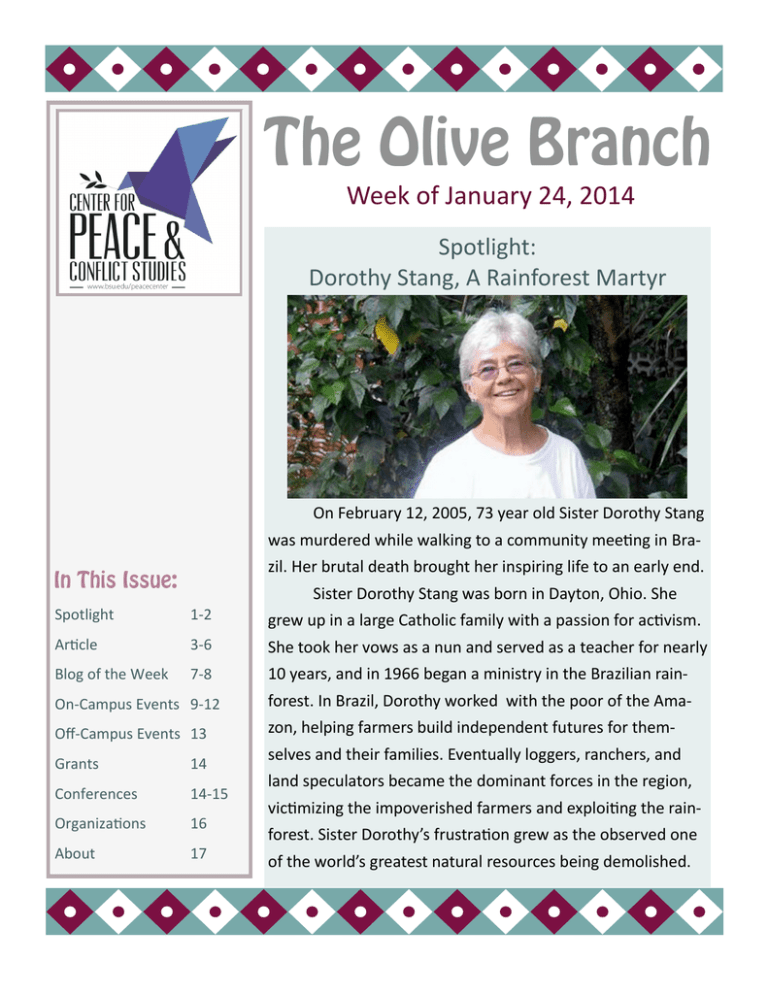
Week of January 24, 2014 Spotlight: Dorothy Stang, A Rainforest Martyr On February 12, 2005, 73 year old Sister Dorothy Stang was murdered while walking to a community meeIng in Bra‐ zil. Her brutal death brought her inspiring life to an early end. Sister Dorothy Stang was born in Dayton, Ohio. She Spotlight 1‐2 grew up in a large Catholic family with a passion for acIvism. ArIcle 3‐6 She took her vows as a nun and served as a teacher for nearly 7‐8 10 years, and in 1966 began a ministry in the Brazilian rain‐ Blog of the Week On‐Campus Events 9‐12 forest. In Brazil, Dorothy worked with the poor of the Ama‐ Off‐Campus Events 13 zon, helping farmers build independent futures for them‐ Grants 14 Conferences 14‐15 OrganizaIons 16 About 17 selves and their families. Eventually loggers, ranchers, and land speculators became the dominant forces in the region, vicImizing the impoverished farmers and exploiIng the rain‐ forest. Sister Dorothy’s frustraIon grew as the observed one of the world’s greatest natural resources being demolished. The Amazon forest is home to nearly 10 percent of the world’s known species. During the past 40 years, close to 20 percent of this rain forest has been cut down. Be‐ cause of Sister Dorothy’s passion for the rainforest and the community, she was put on a death list that was created by the power brokers of the area in the late 1990s, who viewed her as a threat because she was so empowering to the indigenous people. Sister Dorothy was very aware that she had been named to this list and conInued her work, despite the danger she was in. In early 2005, on her way to a meeIng, she was am‐ bushed and shot 6 Imes, le[ in the rainforest to die. She was murdered because she had created programs that generated self‐sufficient communiIes of people commi]ed to their own independence as well as the protecIon of the rainforest. Sister Dorothy is honored and remembered in many ways today. The Catholic Archdiocese of CincinnaI awards the Spirit of Sister of Dorothy Stang Award each year to someone who has kept her ministry alive. In 2008 Daniel Junge directed the docu‐ mentary “They Killed Sister Dorothy.” This documentary brings light to Sister Dorothy’s passion for acIvism and her death. It also follows the trials of the individuals who have been convicted for her murder. Sister Dorothy Stang was an amazing woman who died for what she believed in. She is an inspiraIon to people everywhere, moIvaIng and encouraging them to em‐ brace acIvism for the environment and the people who rely on it. By Kate Giglio In 2001 when Katherine Chon was a senior undergraduate student at Brown University, she took a class covering the histori‐ cal aboliIon of slavery and the existence of slavery and human trafficking in the modern world. It is esImated that anywhere be‐ tween 4 million and 27 million men, women, and children glob‐ ally are currently held as forced laborers or sexual servants. Short‐ ly a[er Chon learned this, the lo‐ cal newspaper in Providence, Rhode Island published an arIcle about six young South Korean women who had become vicIms of sex trafficking and were being forced to work in an area brothel. Shocked that this had occurred in her own back‐ yard, Chon, who is also of South Korean descent, immediately felt compelled to do some‐ thing to prevent other individuals from being enslaved. Chon’s first reacIon was to look for human rights organizaIons at which she could volunteer, but found few that sufficiently addressed the issue of modern‐day slavery. This moIvated her to found her own. Joining with fellow student Derek Ellerman, Chon launched the Polaris Project, a nonprofit organizaIon designed to provide resources for vic‐ Ims of human trafficking and raise awareness about this growing worldwide problem. Named a[er the North Star which guided slaves in the Civil War‐era United States to free‐ dom along the Underground Railroad, the organizaIon was submi]ed shortly a[er its in‐ cepIon to the University's yearly entrepreneur compeIIon where it was awarded funds that allowed Chon to move to Washington, D.C. and establish a permanent headquarters. Chon’s challenge was inImidaIng, but she and her partners were able to rise to the task; the Polaris Project is now one of the most far‐reaching anI‐trafficking organizaIons of its kind. OperaIng the NaIonal Human Trafficking Resource Center, it serves as the principal crisis hotline for incidences of human trafficking in the United States and works to reach out to vicIms by offering social work services and transiIonal housing. Polaris addiIonally helps to assemble local‐level and grassroots anI‐trafficking organizaIons across the naIon. The organizaIon’s wide reach has been essenIal to its mission; in operaIng its naIonal call center and educaIng individuals in various locaIons about recognizing the signs of a po‐ tenIal trafficking situaIon, Polaris is able to have eyes and ears in the parts of the naIon and the world where trafficking is at its worst. This allows them to idenIfy and rescue more vicIms and generate more cases against their oppressors. Chon cites an example of a teacher in an inner‐city area who received training from Polaris in idenIfying potenIal vic‐ Ims of human trafficking. A[er noIcing that two young girls had suspiciously gone missing from an a[er‐school program she was facilitaIng, the teacher reported their absence to the Polaris Project’s hotline. The case was invesIgated, and the two girls were indeed discov‐ ered to have been kidnapped by traffickers, who were subsequently arrested and charged. Chon is seeking a more holisIc approach to the problem of trafficking, however; she acknowledges that vicIm services and community educaIon are essenIal, but she also finds it necessary to translate the horrors experienced by trafficking vicIms into stronger legal policies. Because perpetrators of human trafficking o[en deem their trade to be a rel‐ aIvely low‐risk, under‐the‐radar industry, the Polaris Project works to undermine their op‐ eraIons by generaIng legal obstacles and creaIng stronger repercussions through height‐ ened anI‐trafficking legislaIon on all levels of the government. Chon has parIcularly worked to dra[ state legislaIon, even tesIfying before Congress mulIple Imes to promote anI‐trafficking laws. Chon is confident in her own ability and the abiliIes of individuals around the world to make a significant, meaningful change to their society. “I believe that individuals can make a difference. Follow whatever you are passionate about, embrace it, and don’t be afraid to accept the challenge." For now, Chon’s new challenge is expanding the Polaris Pro‐ ject internaIonally. She wants to see communiIes around the world reach out to stop hu‐ man trafficking and prevent the sale and trade of men, women, and children who are forced to work as slaves. By Emily Hart Are you or someone you know being trafficked? Is human trafficking happening in your community? Is the situa=on you may have encountered actually human trafficking? The following is a list of poten=al red flags and indicators of human trafficking to help you recognize the signs. Common Work and Living Condi/ons: The Individual(s) in Ques/on... Is not free to leave or come and go as he/she wishes Is under 18 and is providing commercial sex acts Is in the commercial sex industry and has a pimp / manager Is unpaid, paid very li]le, or paid only through Ips Works excessively long and/or unusual hours Is not allowed breaks or suffers under unusual restricIons at work Owes a large debt and is unable to pay it off Was recruited through false promises concerning the nature and condiIons of his/her work High security measures exist in the work and/or living locaIons (e.g. opaque windows, boarded up windows, bars on windows, barbed wire, security cameras, etc.) Poor Mental Health or Abnormal Behavior Is fearful, anxious, depressed, submissive, tense, or nervous/paranoid Exhibits unusually fearful or anxious behavior a[er bringing up law enforcement Avoids eye contact Poor Physical Health Lacks health care Appears malnourished Shows signs of physical and/or sexual abuse, physical restraint, confinement, or torture Lack of Control Has few or no personal possessions Is not in control of his/her own money, no financial records, or bank account Is not in control of his/her own idenIficaIon documents (ID or passport) Is not allowed or able to speak for themselves (a third party may insist on being present and/or translaIng Misc. Claims of just visiIng and inability to clarify where he/she is staying/address Lack of knowledge of whereabouts and/or do not know what city he/she is in Loss of sense of Ime Has numerous inconsistencies in his/her story We encourage community members to "look be‐ neath the surface" in all situa=ons they encounter and to be vigilant for poten=al instances of human trafficking. Knowing the red flags and indicators of human trafficking is a key step in iden=fying more vic=ms. If you see any of these red flags, contact the Na=onal Human Trafficking Resource Center hotline at 1‐888‐373‐7888 or text to BeFree (233733) for specialized vic=m services refer‐ rals or to report the situa=on. This list is not exhaus=ve and represents only a selec=on of possible indicators. Also, the red flags in this list may not be present in all trafficking cases and are not cumula=ve. Copyright 2014 The Polaris Project h:p://www.polarisproject.org/human‐trafficking/recognizing‐the‐signs Problems are socially constructed. This means a situaIon is not considered a problem unIl an individual, or a group deems it as such. Environmental issues such as global warming, deforestaIon, and populaIon growth have taken the a]enIon of some Unit‐ ed States organizaIons and individuals, but the majority of the populaIon, including myself, reaps the benefits of obliviousness. The quesIon is why? Why do we Americans ignore the steps being taken towards our own destrucIon? The answer is privilege. DicIonary.com defines privilege as a right, immunity, or benefit enjoyed by a person beyond the advantages of most. The American people, specifically the white, able‐ bodied individuals above the poverty line, take advantage of privilege bestowed to them that other peoples of the world do not experience. These privileges can exceed environmental issues, but for the sake of this blog we will not go there. America’s con‐ sumpIon rate of energy and water is amongst the highest in the world. I take a show‐ er at least once a day; this is a privilege. I brush my teeth twice a day (and I use hot wa‐ ter to rinse my toothbrush); this is a privilege. I am doing this blog post with all the lights in my room on; while the television displays a “no signal” screen in the backdrop; this is a privilege. These are privileges I do not want to give up, and I believe many peo‐ ple feel the same as I. The first three chapters of Joel Andreas comic “Addicted to War” demonstrate how America gained and maintains these privileges. If we, the United States, want something, then we take it. Andreas gives example a[er exam‐ ple of how we as a country have raped and pil‐ laged our way into dominance. This shows that America has, and will conInue to fight for scarce resources. Privilege is a nice thing to have when you are the one benefiIng, but with privilege comes oppression. I take a shower every day because someone else cannot. I brush my teeth twice a day because someone else cannot. I use a computer because someone else cannot. I scored over a four on my ecological footprint quiz because someone else scored considerably lower (this person would not even have access to take the assessment). In the opening paragraph of “The Land Eth‐ ic”, Aldo Leopold states that all things in life are connected. This is a beauIful idea, and in terms of science he is correct, but as of now the human race is not living a life of connectedness. Instead it is one of power, profit, and privilege. Problems of terrorism and homeland security cast a shadow on the environmental movements. The sad truth of the ma]er is the profit margins for destroying and rebuilding are higher than sus‐ tainability. The focus should not be on the impact we have on Earth, but the impact Earth has on us. A[er all, chances are the human race will be gone before the planet is cremated. Dus=n Ward is a student in Gerald Waite’s Introduc=on to Peace Studies and Conflict Resolu=on course. This reflec=on was wriZen for the class blog, which can be found at www.bsupeacestudies.wordpress.com LATINOPALOOZA, 6:00 p.m. ‐ 8:00 p.m., Pruis Hall; The LaIno Student Union will sponsor a talent showcase of Ball State students, faculty and staff. FRIDAY NIGHT FILMWORKS: THE BUTLER, 9:00 p.m., Pruis Hall; The Butler tells the story of a White House butler who served eight American presidents over three decades. The film traces the dramaIc changes that swept American society during this Ime, from the civil rights movement to Vietnam and beyond, and how those changes affected this man's life and family. UNITY WEEK DIVERSITY SYMPOSIUM, 9:30 a.m. ‐ 4:00 p.m., Student Center; A]endees will a]end workshop sessions related to diversity and presented by faculty, staff and students of Ball State University. The keynote speakers are Melinda Messineo, Chairperson of the De‐ partment of Sociology/Associate Professor of Sociology, and Ro‐Anne Royer Engle, Director of the MulIcultural Center. Online registraIon will be open through 5:00 p.m. Thursday, January 16, 2014. Feel free to share this informaIon with your students, colleagues and friends. UNITY SCHOLARSHIP PAGEANT, 7:00 p.m., Pruis Hall; The Unity Scholarship Pageant origi‐ nated in 1968 and is sponsored by the Black Student AssociaIon. The pageant strives to promote unity and hosts over 400 people annually as Mr. and Miss Unity of Ball State Uni‐ versity are crowned. For more informa=on, email Barry Hawkins or call the Office of Student Life, (765) 285‐ 2621. The Department of English is proud to welcome Rachel Marie‐Crane Williams to campus as part of the Marilyn K. Cory Lecture Series. She will deliver a public lecture on gender in comics. Williams is an arIst and teacher at the University of Iowa with a joint appointment between the School of Art and Art History (Intermedia) and Gender Women's and Sexuality Studies. Her work as a researcher and creaIve scholar has always been focused on wom‐ en's issues, community, art, and people who are incarcerated. American alternaIve/single creator comics and graphic novels have been at the heart of her creaIve scholarship for the past few years. Her current projects include a graphic novel about the Detroit Race Riots of 1943. UNDERSTANDING SELF & OTHERS: Group members explore pa]erns of relaIng to self and others by discovering understanding and acceptance of themselves and others. The groups thrive on diversity as members discover the common bond through emoIonal experiences. JOURNEY TO WHOLENESS: Safe, supporIve place for survivors of sexual trauma to explore the meaning of their experiences and to explore effecIve ways of coping. WEIGHT NOT, WANT NOT: SupporIve group for women with eaIng disorders or body im‐ age struggles who want to explore effecIve ways of coping. CHOICES: A group for students who are exploring making changes in their relaIonship with alcohol and other substances. SAFE HAVEN: GLBQ SUPPORT GROUP: This therapy group provides a safe place for GLBQ students to explore and discuss patterns of relating to self and others by discovering under‐ standing and acceptance of themselves and others. Topics of discussion vary greatly from coming out, finding support, relationships, family concerns, depression, anxiety, and/or per‐ sonal growth. MINDFULNESS GROUP: Assists students in alleviating uncomfortable feelings, such as anxi‐ ety, stress, anger, and sadness. The group will practice and discuss relaxation and mindful‐ ness techniques. KALEIDOSCOPE: ETHNIC/RACIAL MINORITY SUPPORT GROUP: Safe, supportive place for ethnic/racial minority students to explore and discuss navigating two or more cultures. Top‐ ics may include discrimination, identity of self, family concerns, relationships, adjustment, academic concerns, and body image. KISS: KNOWING INTERNATIONAL STUDENT STORIES: This gathering is designed to provide support for international students by coming together and sharing cross‐cultural stories. The topics include, but are not limited to, the first year experience of studying in the U.S., friendship, food, cultural holidays, driving experience, classroom culture, relationships with professors and classmates, survival skills (cooking, baking ...etc). Through sharing our sto‐ ries, participants will find similarities and differences as well as gain support from each oth‐ er. The leaders will also share their stories and encourage members’ sharing Please visit the Ball State Counseling Center or call 285‐1736 for more information about Group Therapy and Outreach Group meeting times. This program is designed to help internaIonal students pracIce English, learn studying skills and classroom culture, and make American friends. We recruit both domesIc and interna‐ Ional students from the BSU campus. Through interacIve discussion, they can normalize their experiences and decrease their isolaIon, worries, and stress as well as get support from American students. They will also learn different kinds of study skills to help them suc‐ ceed at Ball State University. We hope through students' parIcipaIon, domesIc students will learn about different cultures without studying abroad and internaIonal students will increase their sense of belonging to BSU and adjust to their transiIon from their countries to BSU be]er. Please call the Counseling Center at 285‐1736 or visit Facebook at BSU Interna=onals for more informa=on. African‐American students at Ball State University have a rich history of campus involve‐ ment and acIvity. As part of the celebraIon of Black History Month, the University Libraries are proud to present The Ball State University African‐American Student Experience, 1970‐ 2013: AcQviQes, OrganizaQons, and Programs, our new exhibit in Archives and Special Col‐ lecIons, on display on the second floor of Bracken Library unIl February 28, 2014. The display draws from several collecIons housed in the Ball State University Libraries Ar‐ chives and Special CollecIons. Featured collecIons are the Black Student AssociaIon Rec‐ ords, the Allen Williams Black Ball State Alumni CollecIon, the Robert Foster Papers, and the Marie Fraser Papers and Photographs. For more informa=on, see the post on the Archives and Special Collec=ons blog, and con‐ tact Archives and Special Collec=ons at 765‐285‐5078 or libarchives@bsu.edu. The weekly vigil protesIng warfare is sponsored by the Indianapolis Peace and JusIce Cen‐ ter. Bring an appropriate sign or have one provided. For more info, phone Gilbert Kuhn at 677‐5967 or email Ron Haldeman at ronjane@igc.org Join us for the CiIzens United for RehabilitaIon of Errants monthly meeIng. For more info, phone Marilyn Reed at 352‐0358 or Lela Ewers at 831‐0765. There will be a Peace Vigil on the theme "War Is Not The Answer!", sponsored by Women's InternaIonal League for Peace and Freedom (Brown County branch). For more info, contact Tom Hougham at 878‐4210 or annntom@hotmail.com If you are looking to make an impact by promoIng cooperaIon and tolerance than this may be for you! Rotary FoundaIon provides fellowships to fund master's degree or pro‐ fessional development cerIficate study at one of the six Rotary Peace Centers. Recipients of this fellowship promote peace, cooperaIon, and successful conflict resoluIon on both the naIonal and internaIonal levels. There are two types of peace fellowships available. The deadline for submitng applicaIons is July 1, 2014. Please visit h]ps://www.rotary.org/en/peace‐fellowships to learn more informaIon. The Annual Notre Dame Student Peace Conference a]racts both undergraduate and graduate students from all across the United States and abroad who are commi]ed to a rigorous, mulI‐disciplinary academic work on peacebuilding. Students present original research and showcase innovaIve peace building pracIces. The conference will be help March 29‐30, 2014. More informaIon regarding deadlines for research proposals will be posted online at kroc.nd.edu/undergraduate/notre‐dame‐student‐peace‐conference as more informaIon becomes available. Through a series of panels, discussions, and speakers, this year's conference parIcipants will gain a historical understanding of the evoluIon of black art and analyze what role different forms of art play in the expression of black culture. The conference is hosted an‐ nually in February at Yale University in New Haven, CT by a student organizaIon. The NCORE conference series consItutes the leading and most comprehensive na‐ Ional forum on issues of race and ethnicity in American higher educaIon. The con‐ ference focuses on the complex task of creaIng and sustaining comprehensive insI‐ tuIonal change designed to improve racial and ethnic relaIons on campus and to expand opportuniIes for educaIonal access and success by culturally diverse, tradi‐ Ionally underrepresented populaIons. The conference will be held in Indianapolis, IN starIng on May 27, 2014 and ending on July 1, 2014. See h]ps:// www.ncore.ou.edu/ for more informaIon. The Peace and JusIce Studies AssociaIon is holding their annual conference in Oc‐ tober 2014 in San Diego, California. Proposal submission deadline is April 1, 2014. The conference will be held on the beauIful campus of the University of San Diego on a mesa overlooking the Pacific Ocean. This year’s conference is Itled “Courageous Presence: Shi[ing Stories and PracIces of Peace.” The University of Massachuse]s Boston will be holding their 10th Biennial Confer‐ ence October 31 through November 1, 2014. The conference will be focused on Conflict Studies and the new generaIon of ideas. Please visit h]p://www.umb.edu/ academics/mgs/crhsgg/conferences for more informaIon. Join these campus organizaIons in their efforts to bring about posiIve change and promote social jusIce around the world! TOMS Campus Club promotes the awareness, reality, and consequences of children living without shoes, and aids in charitable giving to this cause through programming and acIviIes in accordance with the TOMS Shoes com‐ pany. The Center for Peace and Conflict Studies is an interdisciplinary knowledge unit devoted to con‐ ducIng research on various forms of structural and direct violence and conflict, and also dedicated to imple‐ menIng projects that employ nonvio‐ lent strategies to resolve conflict. Our programs include: MediaIon training and services MeditaIon classes The Brown Bag lunch speaker series The Muncie Interfaith Fellowship The Social JusIce League on‐ campus organizaIon Disclaimer: the events described in this newsleZer do not necessarily reflect the views of the Center for Peace and Conflict Studies
